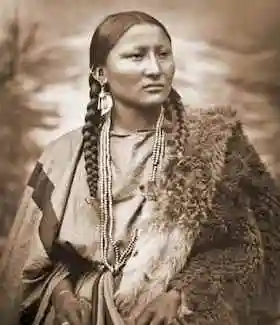Cheyenne love poem
Amôhóomâhtsestôtse
Ta’se, Ne-amôhóomâhtséstoto.
Kásôxe'ohe, Na-háe-momé'hemenó’to'e,
Naa oha, é-nêšévo-hová'âhanéheotse.
Na-ho'óxeve, “Né-méhotâtse.”
Cheyenne language teacher & member of the Indian Affairs bureau


→ French poem ←
My favorite
It is not the first translation i got. I waited almost ten long years to find it. And yet this is the first I have sought.
I have always thought, that the most poetic act will be to translate my poem into Cheyenne. What is the language of women speak, the answer is without doubts, Cheyenne! Their language obviously, is Cheyenne!
It was by searching for Cheyenne, that I found, first the Maya and then the hieroglyphics. These two translations, with the mystery of their glyphs, told me that i was approaching the language of women.
It is the truth, my first desire was to translate my poem into Cheyenne, and only in Cheyenne, and failing that, it has been in hieroglyphics and maya. Then, with all these people who gave to me so easily new translations, everything was chained, and it became like a game, an entry into a new and mysterious world.
And then one day, a teacher of this language appeared. Her distant Indian reserve was getting closer.
Among all the translations, this is the one I prefer, now you know why! Beautiful Cheyenne woman I dedicate this love poem ... only for you.
Cheyenne (Tsitsistas), is an Algonquian language of the High Plains, spoken in the Cheyenne reservations, in southeastern Montana, and in central Oklahoma by approximately 2,000 people. The differences between these two dialects (North and South) are not very important.
Beautiful Cheyenne woman
Love poem (Tsėhésenėstsestȯtse) for the women of the Cheyenne Indian tribes. The French have called them "les chiennes = the bitches" ... Which became ... Cheyenne ... I have a weakness for the Native American languages and of course Cheyenne. They are cries of supplication and invocation.
The Algonquins were proud warriors, they hated cowards and deceivers, And had even given a nickname in the language of the invaders. Black Snake! The Black Snakes, with the charm of black and slimy snakes, in small groups, practiced, in isolated dances, Hypnosis by fire water. Then have destroyed this nation structured. This is all the history of Cheyenne tribes that had told my translator, adding: Distrust from invaders, And practitioners of deceit, in each small dailies, you can not trust them, even and particularly in love.
Cheyenne union of two groups: (Tsétsêhéstâhese = Tsitsistas, et Só'taeo'o = Só'taétaneo'o = Suhtai = Sutaio), are plains Indians of the United States. Led by two councils, one of them military, the Cheyenne tribe was organized into exogamous, matrilineal, and matrilocal clans, and into phratries. Living in tepees (conical tents), they practiced mainly bison hunting and skin work, except for a second group that cultivated corn on the Missouri banks. Shamanism, the sun and 4 arrows ceremonies, played an important role. Cheyenne reserves are in Montana and Oklahoma.
In 1876, despite Fort Laramie treaty, more and more gold seekers were attracted to gold discovered in 1874 in the Black Hills (South Dakota). White people tried to buy this territory, but the Indians dont want to sell mountains they consider as sacred. Sioux, Cheyennes and Arapaho, annoyed by these intrusions on their territory, gathered in camp near the Little Bighorn River. The army is sent to try to bring the Indians back into their reserves. Custer with a column of 209 men, arrives first on the spot, and without waiting for the rest of the troop, decides to attack. He and all his soldiers will be massacred.
Women including Pretty Nose will participate in this battle. She is thought to be part of the Cheyenne group under Little Wolf command. Laton Alton Huffman takes this photo in 1878. Some insure that "on the basis of her red, black and white beaded cuffs" she is an Arapaho and that the photo dates from 1879. It's perhaps true but i rely on the many other sources that name the photo: Pretty Nose, Cheyenne, photographed by Laton Alton Huffman at Fort Keogh in Montana in 1878, to say she is a Cheyenne.
Anyway for me, she is and will remain Cheyenne! She has all the features I imagined for this translation so difficult to find. Her image, mingling with reality all the power of the imagination, an imagination that here according to the sources, will have made two realities: that of her tribe and that of the exact date of this photo. It is obviously her that I needed! Just like the word "Cheyenne" this photo is a very beautiful invitation to the dream!

About the translation (explanations)
Like Your reflection. (mirror implied)
2. Kásôxe'ohe, Na-háe-momé'hemenó’to'e,
Poem, my very beautiful.
3. Naa oha, é-nêšévo-hová'âhanéheotse.
But, it quickly disappears.
4. Na-ho'óxeve, “Né-méhotâtse.”
My last, “I love you.”!
Reference:
1. Your image in the mirrorne-amôhóomâhtséstoto amôhóomâhtsestôtse
2. a) Is my most náno'se - pv. Best; most, supreme. See: háe-; hoháe-; hehpe-; heóme-. é-náno'sepêhéva'e. It is the best. Hé'tóhe tsé-náno'setotóxésto the main thing she talked about (1987:12). Tsé-náno'setotóxem Category: quantity.
b) Beautiful momé'heme- pv. Beautifully ? See: -mo'óna'e. é-momé'hemenóno'e It is desirable (lit. Has beautiful appearance ?).
c) Poem, -kásôxe'ohe vii. Be written short é-kásôxe'ohe. It is written short (for example, something written which is a short piece).
3. a) But, naa
b) Be quick it disappears, -nêševó vii. Be fast é-nêšévo. It is fast/it is rapid. -nêševe'xove vii. Time go fast. Time is “flying” -nêševeotsétó vii. Be fast; rush Naa éohkevésetanoo'o ta'se é-nêševeotséto héstanovestôtse. (now people) are in a hurry, like life is rushed (1987:224).
c) It disappears: -hová'âhanéheotse vii. Disappear; become gone Nássáahéne'enóhénóne tsétâhešê-hová'âhéheotse We did not know how it had disappeared (1987:195) vii. Vai. Lost, disappear Néhe éévamâhe-vona'oo'o. These all disappeared (1987:14) éto'sepêhévo'amó'héto éto'sêsáa-vona'óhane. All will go well, it will never be Lost (1987:104). Final: -a'ó.
4. a) It's my last -hestóxévétó vii. Be last é-hestóxévéto. It is last/it is behind -ho'óxeve vii. Vai. Be the last one; be at the end é-ho'óxeve. He is the end/he is the last one in line/it is the last one in line hestóxe- pv. Last. See: ho'óxe. Tótseha éhováneehéhe éovóehovánee'e heéháme é-hestóxêhováneehóho. Long ago she died, she died first; her husband died after (her).
b) “I love you”! Né-méhotâtse. I love you Né-méhotatséme. I love you (plural).